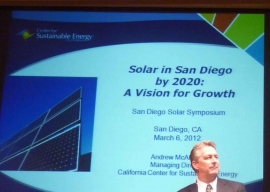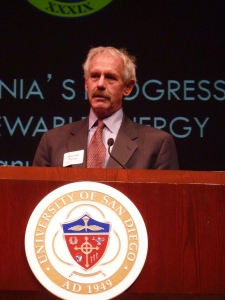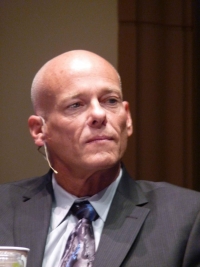“San Diego is becoming a Mecca for renewable energy for the United States.” –Mike Armstrong, Soitec, speaking at the San Diego Solar Energy Symposium

By Miriam Raftery
March 18, 2012 (San Diego) – The future is sunny for solar energy. Price parity with conventional energy sources has now been attained in some areas as demand rises and the cost of solar falls. California has emerged as a national leader in the shift to solar--with San Diego at the helm.
At the San Diego Solar Energy Symposium sponsored by CleanTech San Diego and the Solar Electric Power Association at the University of San Diego on March 6, speakers including a top advisor to the Governor presented reports on the progress of California’s shift to renewable power sources—with solar a shining star in the state’s renewable energy portfolio. How much brighter it will become, however, is dependent on meeting key challenges for the future.
But challenges remain—and one of the greatest is balancing demands from utilities and others pushing large-scale desert solar thermal projects versus advocates of photovoltaic solar, who say locally produced solar on rooftops and parking lots is a more cost-effective and environmentally acceptable strategy.
Here are a few of the most energizing facts to emerge from the conference on solar and renewable energy in California:
- “For PV (photovoltaic solar) we are starting to see price parity” with solar the same price or less than natural gas (source: Michael Picker, senior advisor to Governor Jerry Brown for renewable energy facilities)
- Solar is the fastest growing industry in the United States. (source: Bob Gibson, vice president, Solar Electric Power Association)
- California utilities have enough contracts already signed to produce 40% of their energy from renewable energy sources (source: Michael Picker)
- San Diego has gone from less than 1% of power from renewable to 20% power from renewable (source: Jim Avery, San Diego Gas & Electric)
- California has gone from less than 50 megawatts (MW) of solar installed 10 years ago to 3.5 gigawatts (GW) of solar now connected to the grid (source: Bob Gibson, SEPA)
- San Diego is the leading solar city in California and the nation. Today we have over 100 MW and costs are coming down. (source: Andrew McAllister, California Center for Sustainable Energy)
- When currently contracted projects are built, California will have 16,045 MW- from renewable and will generate close to one-third of the state’s electricity from renewable sources (source: Michael Picker)
- More than half is from solar including 7 ,672 MW of that is from solar photovoltaic and another 2,754 from solar thermal, including 63 MW from the massive Blythe desert solar project (source: California Center for Sustainable Energy)
- Of the remainder, 4,734 megawatts is from wind, 208 MW from geothermal and 344 from biomass (source: California Center for Sustainable Energy)
- Kern County is the state’s largest producer of renewable power, generating 7,168 MW, actively promoting renewable and supporting training programs in community colleges (source: California Center for Sustainable Energy)
- California energy use over the past 35 years has remained flat, thanks to policies promoting conservation and sustainability. Now California has become an “exporter of distributed generation” (source: Michael Picker)
 Despite these strides toward sustainability, there are many challenges—and panelists at the symposium differed in their opinions about what policies and options should best be pursued.
Despite these strides toward sustainability, there are many challenges—and panelists at the symposium differed in their opinions about what policies and options should best be pursued.
The state’s goal put forth by Governor Jerry Brown is to build 12,000 MW of localized electric generation and 8,000 MW of large-scale renewable projects, with planning and permitting related transmission line projects within three years. California also aspires to increase combined heat and power (Cogeneration) by 6,500 MW, as well as other goals such as improving energy efficiencies of buildings and making new buildings net zero.
Picker, who served as an energy advisor to Governor Arnold Schwarzenegger as well as to Governor Brown, says that to meet the state’s ambitious goals for reducing greenhouse gases by 2050 “we must electrify our fleet.” He envisions legions of electric vehicles charged up by users with solar power on their rooftops.
But Picker also believes large-scale desert solar and wind projects are necessary.
He bristled at a question from ECM regarding the destructive environmental impacts of industrial-scale energy projects such as Sunrise Powerlink and Tule Wind in East County.
“If we’re serious about greenhouse gas emissions, we’re going to need it all,” the Governor’s renewable energy advisor insisted.
But others disagreed.
Andrew McAllister of CCSE observed that “land use issues are huge, the bigger the projects get.”
John Bumgarner, regional sales manager for southern California at REC Solar, also serves as a mayoral appointee on San Council’s Sustainable Energy Board. He noted that the call for net-zero metering and consumers to put solar on their roofs raises “real concerns of utilities that this will cut into their profits.”
Cecilia Aguillon, director of market development and government affairs at Kyocera Solar, Inc., said a balance is needed so that “you don’t over-incentivize the market but you don’t’ starve it, either.” She said wind energy is cheaper on the surface, but “the cost too communities is too high.”
Aguillon advocates adoption of a feed-in-tariff to encourage homeowners and business owners to sell 100% of power back to the grid. “The way to do it is to enact a real feed-in tariff where owners of properties—roof space, parking lots, agricultural lands, vineyards, have places where we can install solar and sell it to utilities,” she said.” The beauty of that is that you attract investors. The utility is not going away….In European markets, the rest of the world, they have the feed-in tariff.” Feed-in tariffs have enabled countries such as Germany to rapidly convert to solar, and even Japan, which averages far less sunlight per day than California. Aguillon called the current market situation in the U.S. “sad.”
Ted Ko, associate executive director of the Clean Coalition, contrasted wholesale and resale solar models. “Both have been tremendously successful,” he said, but added that “80% of solar in the world has been installed under feed-in tariffs.”
The U.S. has opted thus far to instead subsidize large wind and solar industrial-scale projects, in much the same way that the oil and coal industries have been subsidized in the past. Proponents contend that there are economies of scale. But those subsidies are up for renewal—and thus far have not won approval in Congress, placing some major projects on the drawing board in jeopardy.
Anoth er challenge is that the shift to renewable resources such as wind and solar, instead of coal and other fossil fuels, means fluctuations in power production since the sun doesn’t always shine and the wind doesn’t always blow. Severe fluctuations could lead to power interruption, so solutions such as battery-based energy storage systems or back-up peaker power plants powered by natural gas need to be factored in.
er challenge is that the shift to renewable resources such as wind and solar, instead of coal and other fossil fuels, means fluctuations in power production since the sun doesn’t always shine and the wind doesn’t always blow. Severe fluctuations could lead to power interruption, so solutions such as battery-based energy storage systems or back-up peaker power plants powered by natural gas need to be factored in.
“A challenge is how to assure that we meet capacity at night, when people want to come home and turn on the TV and start cooking when solar is not producing,” said Thomas Brill, director of strategic analysis at SDG&E.
Brill expressed enthusiasm however for the company’s massive shift toward renewable fuels—a shift incentivized by California’s policies which mandated utility companies reach ambitious renewable goals. “Our role has to be to create a foundation on which the changes that athe state wants will be built,” he said, adding, “We need to steop back and look at our utility model and figure out what we need to do to support a change to a low-carbon, innovative future.” He advocated use of technology such as smart grids as well.
There are success stories in achieving extraordinary leaps to sustainability—notably the University of California San Diego. “We self-generate 92% of our own power on campus,” said Byron Washom, director of strategic energy initiatives at UCSD. His vision includes electrification of our transportation, noting that 30% of electric car owners currently also have solar photovoltaic. “We need PV integrated with electric vehicles and storage…without a doubt, that will be a thing of the future,” he concluded.
Another success locally is Soitec. Business development manager Mike Armstrong said the company is planning 155 MW of solar projects in San Diego County and another 150 MW in Imperial Valley, all 20 MW projects or more, the point at which his company has found cost effectiveness. “San Diego County has been amazingly cooperative and helpful,” he said, also praising Mayor Jerry Sanders. “We said we’d like to build a factory, but we need contracts to build projects,” he recalled. Officials followed through and the company broke ground on its solar factory in December 2011. “We will go into production in December of this year,” said Armstrong.
He added, “San Diego is becoming a Mecca for renewable energy for the United States.”
 SDG&E’s Jim Avery echoed Picker’s call for a variety of renewable energy options. “We need it all,” he said. But overall, he concluded, “This is an incredibly exciting time in our industry…I have a unique opportunity to choose what kind of power to buy…We gave up on coal.” He sees strong potential in solar as well as geothermal and wind energy.
SDG&E’s Jim Avery echoed Picker’s call for a variety of renewable energy options. “We need it all,” he said. But overall, he concluded, “This is an incredibly exciting time in our industry…I have a unique opportunity to choose what kind of power to buy…We gave up on coal.” He sees strong potential in solar as well as geothermal and wind energy.
“We as a community are really setting the stage,” Avery concluded of California’s shift away from fossil fuels and toward renewable fuels and a significant reductions in greenhouse gases that all agree contribute to climate change. “If we don’t act responsibly, we are really leaving our kids with a much worse situation than we came into.”
One key advantage of solar power over our current reliance on foreign oil or coal or wind turbines made overseas, however, is this: “The price of access to the sun is likely to be the same 20 years from now,” Picker, the Governor’s sustainable energy advisor, concluded, “and we won’t have to compete against the Chinese.”









Recent comments